

Mike Healy. Our Tutorial at IJCNN 2009 We gave a tutorial at the International Joint Conference on Neural Networks 2009.

The title is Tutorial A1_T11: Fundamentals of Categorical Neural Semantic Theory, and it was given jointly with my colleague Tom Caudell during the tutorial sessions. Mathematical and theoretical biology. Category theory. A category with objects X, Y, Z and morphisms f, g, g ∘ f, and three identity morphisms (not shown) 1X, 1Y and 1Z.
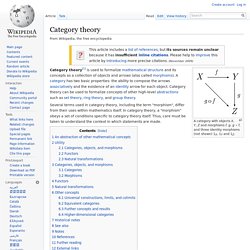
Several terms used in category theory, including the term "morphism", differ from their uses within mathematics itself. In category theory, a "morphism" obeys a set of conditions specific to category theory itself. Thus, care must be taken to understand the context in which statements are made. An abstraction of other mathematical concepts[edit] The most accessible example of a category is the category of sets, where the objects are sets and the arrows are functions from one set to another. The "arrows" of category theory are often said to represent a process connecting two objects, or in many cases a "structure-preserving" transformation connecting two objects. The n. nLab. Physics, Topology, Logic and Computation: a Rosetta Stone. Category Theory. [ Jocelyn Ireson-Paine's Home Page | Publications | Dobbs Code Talk Index | Dobbs Blog Version ] Here is a dialogue I read recently about implementing Windows XP: Daniel de França: Hi John!
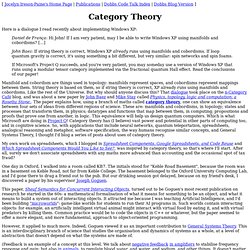
If I am very patient, may I be able to write Windows XP using manifolds and cobordisms? […] John Baez: If string theory is correct, Windows XP already runs using manifolds and cobordisms. If loop quantum gravity is correct, it's using something a bit different, but very similar: spin networks and spin foams. Category Theory and Biology. Category Theory Demonstrations. [ Jocelyn Ireson-Paine's Home Page | Publications | What might Categories do for AI and Cognitive Science?

| n-Category Café thread about Graphical Category Theory Demonstrations ] I've lost a few mails from people who asked about improvements to, or problems with, the demonstrations. One of them was about viewing angle brackets in Windows. If you sent me something and haven't had a reply, could you resend? Thanks. This is an interactive page, with buttons you press to get examples of basic constructions in category theory.
To run the demonstrations, press one of the buttons in the form below these instructions. The demonstrations do not use Java or JavaScript, and so should work in any browser. The demonstrations generate diagrams as well as text, and I'm happy for you to save and use these. Note that the demonstration handles random sets crudely. Saunders Mac Lane. Saunders Mac Lane (4 August 1909 – 14 April 2005) was an American mathematician who co-founded category theory with Samuel Eilenberg.
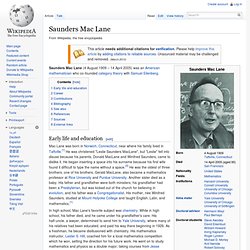
Early life and education[edit] Mac Lane was born in Norwich, Connecticut, near where his family lived in Taftville.[1] He was christened "Leslie Saunders MacLane", but "Leslie" fell into disuse because his parents, Donald MacLane and Winifred Saunders, came to dislike it. He began inserting a space into his surname because his first wife found it difficult to type the name without a space.[2] He was the oldest of three brothers; one of his brothers, Gerald MacLane, also became a mathematics professor at Rice University and Purdue University. Another sister died as a baby. Edsko de Vries - FMG - Research - Computer Science Department - Computer Science - Trinity College Dublin.
TheCatsters's Channel Eugenia Cheng. Simon Willerton. Nicolas Rashevsky. Nicolas Rashevsky (November 9, 1899 – January 16, 1972) was an American theoretical physicist who pioneered mathematical biology, and is also considered the father of mathematical biophysics and theoretical biology.[1][2][3][4][5] Academic career[edit] He studied theoretical physics at the University of Kiev in Ukraine (then Russian Empire) before 1917, and immigrated first to Turkey, then to Poland, France, and finally to the US in 1924 because of the October revolution.

[citation needed] He was awarded a Rockefeller Fellowship in 1934 and went to the University of Chicago to take up the appointment of assistant professor in the Department of Physiology. Major scientific contributions[edit] In 1938 he published the first book on mathematical biology and mathematical biophysics entitled: "Mathematical Biophysics: Physico-Mathematical Foundations of Biology. " In the same year he established the World' s first[citation needed] PhD program in Mathematical Biology at the University of Chicago.
Robert Rosen (theoretical biologist) Panmere. The Mathematics Genealogy Project - Aloisius Louie. More Than Life Itself: A Synthetic Continuation in Relational Biology (Categories) (Volume 1) (9783868380446): A. Louie. MEMORY EVOLUTIVE SYSTEM HomePage. Untitled Document. Innovaxiom - Conférence mathématiques innovantes 2010 - Andrée Ehresmann. Memory Evolutive Systems; Hierarchy, Emergence, Cognition, Volume 4 (Studies in Multidisciplinarity) (9780444522443): A C Ehresmann, J.P. Vanbremeersch. Functor in nLab. Graph in nLab. HaskellWiki. Category theory. Haskell/Category theory. This article attempts to give an overview of category theory, in so far as it applies to Haskell.
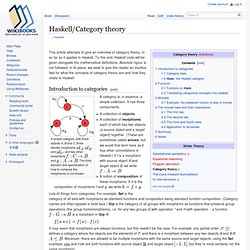
To this end, Haskell code will be given alongside the mathematical definitions. Absolute rigour is not followed; in its place, we seek to give the reader an intuitive feel for what the concepts of category theory are and how they relate to Haskell. Introduction to categories[edit] Learning Haskell through Category Theory, and Adventuring in Category Land: Like Flatterland, Only About Categories « Monadically Speaking: Adventures in Programming Language Theory. Two days ago, there was an interesting post by Andrzej Jaworski, entitled “[Haskell] Teach theory then Haskell as example,” dated “Wed, 14 Jan 2009 04:37:33 +0100,” on the Haskell mailing list on the Haskell programming language, recommending that Haskell be taught “on most abstract terms in a framework of higher order logic, types and CT right from the start.”
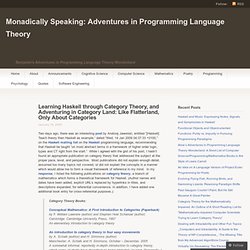
While I agreed with the gist of his post, I hadn’t found an appropriate publication on category theory that addressed the subject at the proper pace, level, and perspective. Most publications did not explain enough detail, assumed too many topics not covered, or did not explain the concepts in a manner which would allow me to form a visual framework of reference in my mind. CatTheory and Func Prog Michiexile/MATH198. Computational category theory. Welcome to the Computational Category Theory Project Computational Category Theory is an implementation of concepts and constructions from category theory in the functional programming language Standard ML.
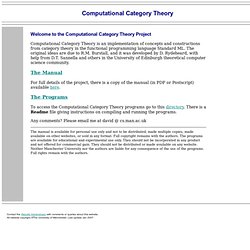
The original ideas are due to R.M. Burstall, and it was developed by D. Rydeheard, with help from D.T. Sannella and others in the University of Edinburgh theoretical computer science community. The Manual For full details of the project, there is a copy of the manual (in PDF or Postscript) available here. The Programs To access the Computational Category Theory programs go to this directory. Any comments? The manual is available for personal use only and not to be distributed, made multiple copies, made available on other websites, or sold in any format. Standard ML. SML is a modern descendant of the ML programming language used in the Logic for Computable Functions (LCF) theorem-proving project.

It is distinctive among widely used languages in that it has a formal specification, given as typing rules and operational semantics in The Definition of Standard ML (1990, revised and simplified as The Definition of Standard ML (Revised) in 1997).[1] Language[edit] fun factorial n = if n = 0 then 1 else n * factorial (n-1) A Standard ML compiler is required to infer the static type int -> int of this function without user-supplied type annotations.
I.e., it has to deduce that n is only used with integer expressions, and must therefore itself be an integer, and that all value-producing expressions within the function return integers. Functional Programming Course. Overview The purpose of this course is to introduce the theory and practice of functional programming (FP). The characteristic feature of FP is the emphasis on computation as evaluation. The traditional distinction between program and data characteristic of imperative programming (IP) is replaced by an emphasis on classifying expressions by types that specify their applicative behavior.